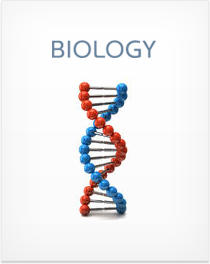DNA Replication and Protein Synthesis
This section covers the following topics
- DNA and RNA structure and function
- DNA replication
- Protein synthesis
- Gene regulation
- Mutations and errors in DNA replication
- Biotechnology
Section Summary
DNA and RNA contain blueprints for all the proteins a cell can produce. Individual DNA or RNA nucleotides have lettered nitrogen bases. Pairs of nitrogen bases are complementary, providing a mechanism for proofreading and repair.
DNA replication is accomplished by DNA polymerase. This process is assisted by RNA polymerase, helicase, DNA ligase and topoisomerase. DNA replication proceeds in one direction only, necessitating the formation of Okazaki fragments during the replication of the lagging strand. The leading strand is synthesized continuously.
Protein synthesis has three main stages. During transcription, an mRNA copy is made of the DNA. It is then processed. Introns are removed from the mRNA by SNURPS, leaving only exons. A protein cap and poly(A) tail are added to the mRNA to protect it from the restriction enzymes that it will encounter within the cytoplasm. During translation, ribosomes form on the mRNA. tRNA molecules interact with the ribosome and add a nucleotide to the growing protein if the anti-codon on the tRNA matches the codon under consideration on the mRNA. The protein spontaneously folds as it develops.
Eukaryotic genes are switched on and off by transcription factors. In bacteria, structures called operons provide multiple methods of regulation. Operons contain multiple structural genes and lead to the creation of multiple proteins when transcribed.
Point mutations, which are relatively insignificant, occur when a single nucleotide is altered. More serious frameshift mutations occur when a nucleotide is added or deleted. Frameshift mutations alter every single codon (sequence of three nucleotides that encodes a specific protein) that appears after them in the DNA. Many errors are corrected by DNA polymerase itself, which can tell based on the DNA... Sign up to continue reading DNA Replication and Protein Synthesis >
